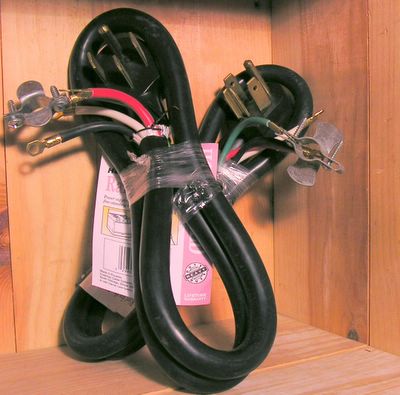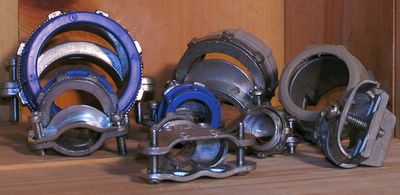Clean Clothes and Cooked Food
Clean Clothes and Cooked Food
The Laundry
Since both the clothes dryer and the cooking range in our house are electric, we must run cable to these two major electric appliances. For the Electric Clothes Dryer, which utilizes a 30 amp, 120/240 volt 4-wire receptacle, we use 10/3 romex. Size 10/3 romex is a cable assembly which consists of four conductors, all # 10 American Wire Gauge (AWG); with an insulated black and a red, considered current- carrying conductors, an insulated white, or neutral conductor (the ground-ed conductor) and a bare (no insulation) ground-ing conductor, called an equipment ground, to properly ground the circuit or device.
This 10/3 cable is pulled in between the electrical panelboard in the back hall to the dryer receptacle. With the washing machine and clothes dryer inside the closet, adjacent to the panelboard, this isn’t a very long pull. The cable is run into usually a 2-gang switch box, mounted around 36" above the floor, or so as to best serve the appliance. When the appliance is set in place, a proper 30 amp 4-wire cord must be used to bring the two live conductors, the neutral, ground-ed conductor and the ground-ing or equipment ground conductor to the appliance.
Cooking for Starters
The Electric Range requires a heavier cable than the Clothes Dryer, and utilizes a 50 amp, 120/240 volt 4-wire receptacle. This is served to the appliance with an 8/3 romex cable, which like the 10/3 cable has four conductors, in this case all # 8 AWG. An insulated red and black, or current-carrying conductors, an insulated white, neutral conductor, ground-ed conductor and a ground-ing conductor, to properly ground, in this case the receptacle and subsequently the range itself.
The range cable, as it is called at this point, requires the use of larger staples to fasten it to the studs and joists and the connectors are larger where this cable terminates in a deep 4-11/16" square steel box.
It utilizes a 4-wire receptacle mounted on a raised box cover and fastened so it stands proud of the wall by the depth of the box itself (2-1/8") plus the raised cover (½") and device (1/8") and the 50 amp 4-wire cord and cap (5/8"). This assembly must be mounted so that the appliance can be plugged into the receptacle and the range itself located such that the two don’t compete with each other for space, you’ll want to make sure there is a void at the back of the range to accommodate the depth of this assembly.

Electric Clothes Dryer and Range, 4-wire Cordsets
Another way to accomplish the range receptacle installation is to mount a 4-wire 50 ampere surface mount self-contained receptacle, these are available for the 30 amp clothes dryer receptacle and the 50 amp electric range receptacle. Like the electric dryer receptacle, where the box is mounted inside the wall cavity, the same installation technique can be applied.
Clamping for Lack of Mobility
I will mention here that all cables entering electrical boxes; most especially steel electrical boxes, per NEC must be installed in an approved connector with a clamp and two screws to tighten down and hold fast the cable in the connector. In some cases, where the connector is larger than 3/4", a non-metallic bushing is required to further protect the cable from the chafing effects caused from a cable left loosely in the connector. The point here is that, if there is a sharp steel edge against which the cable assembly scratches, there will be physical damage inflicted upon the cable sheath and eventually cutting through the insulation and eventually (and inevitably) causing a short circuit.
A Little Vibration
I should mention that I have encountered some of these cables left in loosed connectors and found in some cases that vibration has done most of the damage. What vibration? Consider that a large truck, driving by your house, cause a rumble in the earth that you can feel, applying these same factors to the electrical box situation, you can see the problem is a very real one.
Home Runs Without Rounding the Bases
The home-run cables are all brought to the main panelboard for connection to the power source, through the eventual use of circuit breakers. Each cable must be run through an approved two-screw connector and, if the connector is 3/4" or larger, we also need to install a non-metallic bushing, over the end threads of the connector to protect the cable from chafing damage. The reason that smaller cables don’t require non-metallic bushings? The larger cables are much stiffer and weigh more and thus more damage is done to the cable insulation when pressed against a sharp steel edge.

Various 2-Screw Cable Connectors, Note Blue Plastic Bushings on Size 3/4" Connectors and Larger.
Once inside the panelboard, the individual conductors of the cables are separated from each other and connected to the various electrical busses. An electrical buss is basically a terminal strip, or a common place to terminate the various sized conductors, held tightly in place under set-screws.
Public Transportation It is Not
A Ground Buss is a terminal strip for the ground-ing conductors. Bare copper; sometimes with green insulation; sometimes green and yellow striped. Solid copper or stranded conductors each one is placed under a set screw and tightened down fast. Assuring the screws are turned in tight is essential to electrical safety, a loose connection causes a voltage drop, as the current flow soars conversely, overheating and arcing, or sparks caused from the “chatter” of the loose connection. This condition is the number one cause of electrical fires, through-out the world. More on that later.
A Neutral Buss is a terminal strip for the ground-ed, or neutral conductors of the 120/240 volt system. I do not understand why they do this, but the NEC does not use the term “Neutral” for the Ground-ed conductor, they simply refer to this conductor as the Gound-ed conductor. This simple lack of definition cause a great deal of confusion, even for the veterans (like me) who skim the text of a dog eared Code Book and find themselves confusing the two terms. Anyway, the neutral conductors are individually connected to the terminal strip with a single conductor, solid or stranded, each under it’s own single set-screw.
Power Please
The remainder of the conductors are the power connections to the individual circuit breakers within the panelboard. Each “circuit” has it’s own characteristics, as I have mentioned before, with each conductor size warranting it’s own properly-sized circuit breaker (over-current) device. A # 14 conductor is protected at 15 amps; #12 at 20 amps; a #10 at 30 amps, and a 38 at 50 amps, etc., etc.. Over fusing is another area that causes a great deal of confusion also, not to mention fires, but this time it is not the electrician that is mistaken, for he knows better. This time it is the unaware homeowner that does the deed (overfuses) and cause an unsafe condition, - overheated conductors causing insulation failure, or worse, and eventually a very hazardous situation for the occupants of the house.
A 120 volt circuit, having it’s white and ground conductors connected to the neutral and ground buss, is powered by a properly sized single-pole circuit breaker. A 240 volt circuit, such as the electric range and the electric dryer we have in our house, is powered by a properly sized double-pole circuit breaker. At this stage of the job, the rough in, we are not installing circuit breakers, that will come later.
The panelboard must be covered to protect it during the construction period to keep contaminants (construction debris and water) from damaging the electrical connections and components.
We will be installing the service to this house soon, stay with us......

0 Comments:
Post a Comment
<< Home